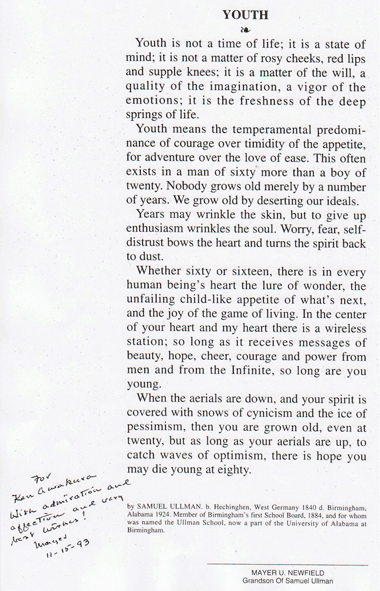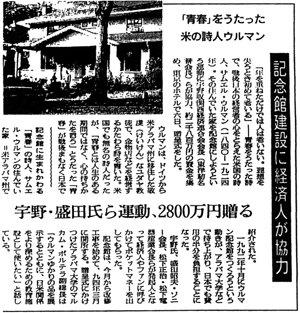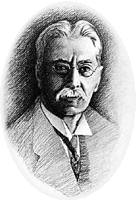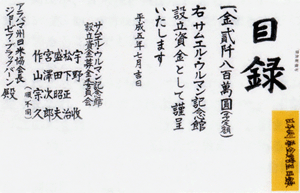
3
Mr. Akio Morita and the Samuel Ullman Museum
(A Commemoration) By Kenji Awakura
How many of you know this poem now?

(Above as Presented to Awakura from Mr. Mayer Ullman Newfield on 1993)
Whenever I read this prose poem, which is noted as the text most frequently quoted by Japanese people in recent years, I cannot help but recalling unforgettable memories of Mr. Akio Morita.
The poem “Youth,” written by Samuel Ullman, was said to be carried in the wallets of those industrialists who made Japan the second largest economy in the world as the country was recovering from the disaster of defeat suffered in World War II.
Mr. Akio Morita, who has been called “the model Japanese manager,” also carried this poem in his heart as he worked toward pushing the Sony Corporation and Japan into the world’s leading position, I am told. I would like to relay here a few anecdotes regarding his activities.
 July 7, 1993 Asahi Newspaper : All rights reserved
July 7, 1993 Asahi Newspaper : All rights reserved
About 15 years ago, on July 7, 1993, Japanese newspapers reported “Home of ‘Youth’ Poet Samuel Ullman Converted to Museum: Japanese Industrialists Cooperate.” They reported on the success of the fund-raising campaign in Japan to help establish the museum, and on the ceremony to hand over these funds to the U.S.
On the front page of the very same newspapers were pictures of U.S. President Bill Clinton, who was visiting in Japan at the time. The angry, troubled look on his face seemed to clearly depict, “The U.S. and Japan are in the worst relationship ever. “ The article about the “Samuel Ullman Event,” on the other hand, tried to highlight the contrast between the Ullman event and the “U.S.-Japan Economic War.” The Ullman event was “a symbol of goodwill between the U.S. and Japan!”
On the day before the article appeared in the paper, a ceremony was held at a hotel in Tokyo to hand over the funds from the Japanese fund-raising committee to the Japan-America Society of Alabama (JASA). The assembly included 20 people from the media. Dr. Malcolm Portera, Vice-Chancellor of the University of Alabama, flew in to represent the U.S side. Mr. Morita, Vice-President of the Japan Federation of Economic Organizations (“Keidanren”) made a speech, together with Mr. Osamu Uno, President of the Kansai Economic Federation (“Kankeiren”). They represented the Japanese side. This event was reported in the U.S. media also.
In those days, both these gentlemen were very well known for their activities towards building goodwill between the U.S. and Japan. It was not as well known that they had both received the Samuel Ullman Award (1992 – Mr. Morita; 1994 – Mr. Uno), an award which is presented to those who make distinguished contributions toward building goodwill between the U.S. and Japan.
(The ‘Samuel Ullman Award’ is presented by JASA at their Annual Dinner or other JASA occasions every spring.)
 Samuel Ullman
Samuel UllmanPrior to this, in the summer of 1992, the house where Samuel Ullman wrote the poem “Youth” was to be sold and demolished. I, in charge of a business in Alabama at that time, was asked by the owner of the house to buy and save it. I happened to assume the position of First Vice-President of JASA, handed down from Mr. Kawashima and Mr. Chubachi, President and Vice-President of Sony Magnetic Products Company in Alabama, respectively. I took on the project as a formal JASA event and took charge of it myself. I requested that members and supporters from both the U.S. and Japan raise half of the necessary funds each.
The following people joined the fund-raising committee:
- Mr. Osamu Uno, Honorary Chairman of TOYOBO CO., LTD. and co-author of the book A Poem Named “Youth”
- Mr. Masaharu Matsushita, Chairman of Matsushita Electric Industrial Co., Ltd.
- Mr. Akio Morita, Chairman of Sony Corporation
- Mr. Jiro Miyazawa, Former Chairman of Toppan Moore Co., Ltd. and the author of the book An Impressive Poem “Youth” and
- Mr. Munehisa Sakuyama, Counsel at Chiyoda Corporation and the co-author of A Poem Named “Youth”
 List of the contents of presentation
List of the contents of presentation
The project was a big success. Even though it was during the “burst of the economic bubble” and resulting recession, the Japanese side’s target amount of 28 million yen was reached in two months, well ahead of the one-year deadline originally set by the project. This was the result of the private donations from Mr. Morita and the other Japanese industrialists who had gained courage and active spirits from the poem “Youth,” and were helped by the poem to work progressively in their daily activities.
The poem “Youth” is in actuality “a song for life” that cheers and encourages the heart. This poem is always listed in “the top 5 texts loved by corporate management in Japan.”
The funds donated by people all over Japan were collected by the Council for Better Corporate Citizenship, CBCC, at Keidanren, sent to the USA, put together with the funds raised there, and finally, the house was purchased. The house was saved from being torn down and is now the Samuel Ullman Museum, which was opened in March, 1994.
Lastly, I would like to relate an episode that is known only among people involved in the project. In the middle of the above-mentioned fund presentation ceremony from Japanese to U.S. representatives, Mr. Morita was given notice by a journalist: “Mr. Morita, the event with President Clinton and leaders of the economic world is starting shortly!” Mr. Morita replied instantaneously, “This fund presentation ceremony is very important for us who are doing business as good corporate citizens crossing national borders. He completed the event and then attended the activity with the U.S. President. This is the story conveyed by Mr. Ogi, then Representative of the State of Alabama in Japan. Hearing this, I felt I had learned another lesson from Mr. Morita: how one can be a real ‘U.S.-Japan Bridge’ and what the spirit of the poem “Youth” really is.
The Samuel Ullman Museum is located in the city of Birmingham, Alabama. It is a symbol of goodwill between people of the USA and Japan. This new cultural asset of the USA has been visited by people from 27 countries.

Samuel Ullman Museum
Written by Kenji Awakura
The First Vice-President, President-Elect of the Japan-America Society of Alabama (1993);
Vice-President and Acting President, JVC America, Inc.
• The titles of persons and the names of organizations referred to in this article are as of 1993.
• All rights reserved for the articles of The Asahi Newspaper and others quoted in this work as well as this article itself.
Links:
• Samuel Ullman Museum (English)
• New Youth Club (Tokyo)Association of the Lovers of the Poem “Youth” (Japanese)
• Maebashi Youth Club (Gunma Prefecture)
“Youth” Poem Lovers’ Association of the Birmingham’s Sister City, Maebashi (Japanese)
• Economic, Cultural, and Sightseeing Information of the State of Alabama (English)
If you have any recollections of Akio Morita, or would like to leave a message about him, please let us know. (Please indicate if you wish to remain anonymous or to use a pseudonym.) Submit a contribution





























